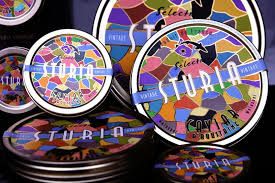11/12/2013
Le caviar Sturia mis à l'honneur chez Harrods
Like Neptune in waders, a burly Frenchman emerges from the water cradling a large black fish in his arms. He carefully lifts it into a holding net and strides back to catch more with his bare hands. When fishing for sturgeons that are effectively filled with caviar, a gentle touch is required.
The scene takes on a surreal edge when the fish is then scanned with an ultrasound device. A grainy image appears on the screen showing the precious roe that will eventually become caviar. But they are deemed not ready for harvesting, so the fish is returned to the water.
It’s all in a day’s work at Sturia – a company that has been farming caviar for nearly 20 years near the wine city of Bordeaux. Regarded as a pioneer in its field, it was one of the first to develop caviar-farming techniques, and today the fruits of its labour are served by Michelin-starred restaurants and exclusive food stores.
Demand has reached new heights since a ban on wild-caviar exports in 2006 in response to years of overfishing in the Caspian Sea. “When we started, we were considered the crazy guys,” says Sturia’s CEO, Laurent Dulau. “At that time, the world was dominated by wild caviar. Twenty years later, we don’t seem so crazy. Today, catching wild sturgeon is forbidden, and will remain so for the next 10 to 15 years.”
With its sharp snout and beard-like barbels, the sturgeon is no beauty, but don’t be deceived by its dowdy appearance. This fish has existed for more than 250 million years and can live for 100 years in the wild, weighing as much as a car and measuring nearly 20 feet in length. Farmed fish never achieve such monster proportions, but still take years to reach maturity.
Once the roe is finally harvested, turning it into caviar is relatively simple.
The eggs are washed, salted and packed in tins; but Sturia has also developed innovative aged caviars (Primeur, Vintage and Origin), matured to offer contrasting flavours and textures.
The difference between the three becomes clear during a masterclass from Dulau in the company’s new training kitchen. The shiny beads of caviar are darker with a softer texture and a more intense flavour the longer they have been matured. 
“Primeur is aged for one month and is light, delicate and subtle, with a firm texture and a hint of green hazelnuts,” he explains. “Origin is very different – more like wild Russian caviar. It’s aged for more than eight months and is tender and powerful, with hints of ripe fruit and intense hazelnut.” At three to eight months old, Vintage sits between the two.
Dulau spoons surprisingly large portions of the tiny black pearls onto the backs of our hands (a technique used to prevent contamination) before advising us to roll the caviar around our palates to appreciate the complex flavours. He enthuses, “Caviar is wonderful on its own, but also as an ingredient. We work with chefs who use it like a condiment to bring dishes alive.”
Most people are unlikely to replace their salt and pepper with caviar any time soon, because it remains one of the world’s most valuable foods. The move to sustainable production has done little to dent prices, with farmed caviar costing almost as much as wild once did.
Sturia has introduced some beluga sturgeon to its ponds, but they take 12 years to reach maturity; the company also produces limited amounts of golden oscietra caviar. But it is the Atlantic sturgeon that is Sturia’s finest achievement. Once native to the Gironde river, the species died out due to overfishing and pollution, but Sturia is now rearing the fish to release back into the wild.
It’s a long-term project. But the dream is that wild sturgeon will one day swim again in the Gironde. Not bad for a company set up by “crazy guys”.
Patrick McGuigan Copyright © 2013 Harrods Magazine Limited.
18:50 Publié dans Actualités | Commentaires (0) | ![]() Facebook | |
Facebook | |
06/12/2013
Pharmacie en ligne
 Lundi matin : besoin de paracétamol. Je me rends dans la pharmacie du village … Nom d’une pipe, qu’est ce que les prix ont augmenté…. La boîte de générique que je payais 1.48 € est grimpée à 1.90 €. ( Le Doliprane, lui, est vendu à 1.95 €…)
Lundi matin : besoin de paracétamol. Je me rends dans la pharmacie du village … Nom d’une pipe, qu’est ce que les prix ont augmenté…. La boîte de générique que je payais 1.48 € est grimpée à 1.90 €. ( Le Doliprane, lui, est vendu à 1.95 €…)
Curieuse, et mal à l’aise, je suis allée sur le net…et voici ce que j’ai trouvé :
Chez unooc.fr, (un comparateur de prix) : le Doliprane est à 1.55, Le paracetamol de Biogaran, Teva et quelques autres sont à 1.50. Quant aux laboratoires Sandoz, ils proposent leur molécule Paracetamol à 0.93 cts
Ça laisse pensif…. La sécu doit voir rouge, qui rembourse toujours le prix fort…Et moi, je bouille d’être autant prise pour un crétin… qu’est ce qui ne tourne pas rond ?
Je ne sais pas pour vous, mais moi, je vais encore accentuer mes courses en ligne… y compris pour la Pharmacie… Les frais de port sont remboursés assez rapidement. Il suffit de planifier l’achat de la crème solaire d’été, des pastilles pour la gorge, de la crème de jour, du dentifrice, de la vitamine et cie…
J’en veux à mon pharmacien de me taxer si fort…. Il ne me verra plus que sur ordonnance !
Je me dis qu’à force d’être trop gourmands, tous ces pharmaciens scient eux-mêmes la branche sur laquelle ils sont assis…
Notez que je ne suis pas la seule à me poser des questions : http://www.ladepeche.fr/article/2012/03/29/1318245-les-pharmaciens-montres-du-doigt.html
ps : j'ai recu mon colis. Des recommandations sont écrits manuellement sur ma commande, et j'ai meme reçu un coup de fil de la pharmacienne....
08:02 Publié dans Actualités, Associations, Bons plan, sante | Commentaires (0) | Tags : pharmacie, pharmacie en ligne | ![]() Facebook | |
Facebook | |


